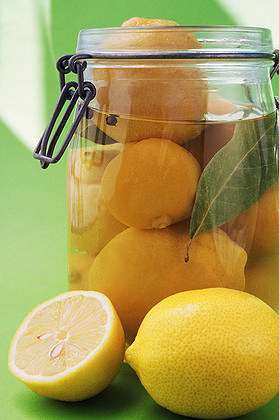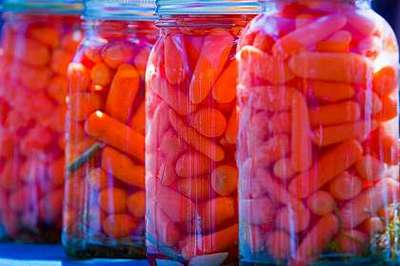General Information
The many varieties of pickled and fermented foods are classified by ingredients and method of preparation.
Regular dill pickles and sauerkraut are fermented and cured for about 3 weeks. Refrigerator dills are fermented for about 1 week. During curing, colors and flavors change and acidity increases. Fresh-pack or quick-process pickles are not fermented; some are brined several hours or overnight, then drained and covered with vinegar and seasonings. Fruit pickles usually are prepared by heating fruit in seasoned syrup acidified with either lemon juice or vinegar. Relishes are made from chopped fruits and vegetables that are cooked with seasonings and vinegar.
Be sure to remove and discard a 1/16-inch slice from the blossom end of fresh cucumbers. Blossoms may contain an enzyme which causes excessive softening of pickles
معلومات عامة
تصنف العديد من الأصناف من الأطعمة المخمرة ومخلل من المكونات وطريقة التحضير.
والمخمرة العادية المخللات الشبت ومخلل الملفوف ومملح لمدة 3 أسابيع. والمخمرة dills الثلاجة لمدة حوالي 1 أسبوع. خلال الألوان، وعلاج وتغير النكهات وزيادة الحموضة. لا المخمرة المخللات العذبة أو حزمة سريعة عملية، ويتم التجفيف بعض عدة ساعات أو بين عشية وضحاها، ثم ينضب ومغطاة الخل والتوابل. وعادة ما يتم المخللات الفاكهة التي أعدتها الفاكهة في شراب التدفئة محنك المحمضة مع أي عصير الليمون أو الخل. مصنوعة من الفواكه المذاق المفروم والخضروات التي يتم طهيها مع التوابل والخل.
تأكد من إزالة وتجاهل شريحة 1/16-inch من نهاية زهر من الخيار الطازج. قد تحتوي أزهار انزيم الذي يسبب الإفراط في تليين المخللات
Caution: The level of acidity in a pickled product is as important to its safety as it is to taste and texture.
• Do not alter vinegar, food, or water proportions in a recipe or use a vinegar with unknown acidity.
• Use only recipes with tested proportions of ingredients.
• There must be a minimum, uniform level of acid throughout the mixed product to prevent the growth of botulinum bacteria.
Ingredients
Select fresh, firm fruits or vegetables free of spoilage. Measure or weigh amounts carefully, because the proportion of fresh food to other ingredients will affect flavor and, in many instances, safety.
Use canning or pickling salt. No caking material added to other salts may make the brine cloudy. Since flake salt varies in density, it is not recommended for making pickled and fermented foods. White granulated and brown sugars are most often used. Corn syrup and honey, unless called for in reliable recipes, may produce undesirable flavors. White distilled and cider vinegars of 5 percent acidity (50 grain) are recommended. White vinegar is usually preferred when light color is desirable, as is the case with fruits and cauliflower.
Pickles with reduced salt content
Recipes for pickles with reduced sodium content are provided in Guide 6 of the USDA Complete Guide to Home Canning.
In the making of fresh-pack pickles, cucumbers are acidified quickly with vinegar. Use only tested recipes formulated to produce the proper acidity. While these pickles may be prepared safely with reduced or no salt, their quality may be noticeably lower. Both texture and flavor may be slightly, but noticeably, different than expected. You may wish to make small quantities first to determine if you like them.
تنبيه: مستوى الحموضة في المنتج مخلل لا يقل أهمية عن لسلامته كما هو الطعم والملمس.
• لا يغير الخل، والغذاء، أو نسب المياه في وصفة أو استخدام الخل مع حموضة غير معروف.
• استخدام وصفات فقط مع نسب اختبار المكونات.
• يجب أن يكون هناك حد أدنى، مستوى موحد من خلال المنتج حمض مختلطة لمنع نمو البكتيريا البوتولينوم.
المكونات
حدد الطازجة، والفواكه أو الخضار شركة خالية من التلف. قياس وزن أو المبالغ بعناية، لأن نسبة المواد الغذائية الطازجة لمكونات أخرى سوف تؤثر على نكهة و، في كثير من الحالات، والسلامة.
استخدام التعليب أو التخليل الملح. قد لا تضاف إلى المواد التكتل الأملاح الأخرى جعل غائما محلول ملحي. منذ الملح تقشر تختلف في الكثافة، فمن غير المستحسن لصنع الأطعمة المخللة والمخمرة. وغالبا ما تستخدم حبيبات بيضاء السكريات والبني. شراب الذرة والعسل، إلا إذا دعت لفي وصفات موثوق بها، قد تنتج النكهات غير المرغوب فيها. ويوصى الأبيض المقطر وعصير التفاح والخل من الحموضة في المئة 5 (50 الحبوب). وعادة ما يفضل الخل الأبيض لون فاتح عندما أمر مرغوب فيه، كما هو الحال مع الفواكه والقرنبيط.
المخللات مع انخفاض محتوى الملح
وتقدم وصفات لالمخللات مع انخفاض محتوى الصوديوم في دليل 6 من دليل USDA الكامل لتعليب الرئيسية.
في صنع المخللات حزمة العذبة، ويحمض الخيار بسرعة مع الخل. استخدام وصفات اختبار فقط وضعت لإنتاج الحموضة المناسبة. في حين قد يكون مستعدا هذه المخللات بأمان مع الملح انخفاض أو لا، قد تكون جودتها أقل بشكل ملحوظ. قد حد سواء تكون نسيج ونكهة قليلا، ولكن بشكل ملحوظ، مختلفة مما كان متوقعا. قد ترغب في جعل كميات الصغيرة أولا لتحديد ما إذا كنت مثلهم.
However, the salt used in making fermented sauerkraut and brined pickles not only provides characteristic flavor but also is vital to safety and texture. In fermented foods, salt favors the growth of desirable bacteria while inhibiting the growth of others. Caution: Do not attempt to make sauerkraut or fermented pickles by cutting back on the salt required.
Firming agents
Alum may be safely used to firm fermented pickles. However, it is unnecessary and is not included in the recipes in this publication. Alum does not improve the firmness of quick-process pickles. The calcium in lime definitely improves pickle firmness. Food-grade lime may be used as a lime-water solution for soaking fresh cucumbers 12 to 24 hours before pickling them. Excess lime absorbed by the cucumbers must be removed to make safe pickles. To remove excess lime, drain the lime-water solution, rinse, and then resoak the cucumbers in fresh water for 1 hour. Repeat the rinsing and soaking steps two more times. To further improve pickle firmness, you may process cucumber pickles for 30 minutes in water at 180°F. This process also prevents spoilage, but the water temperature should not fall below 180°F. Use a candy or jelly thermometer to check the water temperature.
Preventing spoilage
Pickle products are subject to spoilage from microorganisms, particularly yeasts and molds, as well as enzymes that may affect flavor, color, and texture. Processing the pickles in a boiling-water canner will prevent both of these problems. Standard canning jars and self-sealing lids are recommended. Processing times and procedures will vary according to food acidity and the size of food pieces.
ومع ذلك، فإن الملح المستخدمة في صنع مخلل الملفوف المخمر والمخللات التجفيف ليس فقط يوفر نكهة مميزة ولكن أيضا حيوية لسلامة والملمس. في الأطعمة المخمرة والملح تفضل نمو البكتيريا مرغوب فيه بينما منع نمو الآخرين. تنبيه: لا تحاول جعل مخلل الملفوف المخمر أو المخللات من خلال خفض الملح المطلوب.
ثبات وكلاء
ويمكن استخدامها بأمان الشب لترسيخ المخللات المخمرة. ومع ذلك، فمن غير الضروري وغير المدرجة في وصفات في هذا المنشور. الشب لا يحسن ثبات عملية سريعة المخللات. الكالسيوم في الجير يحسن بالتأكيد المخلل الحزم. ويمكن استخدام الغذاء الصف الجير الجير كحل لتمرغ في المياه العذبة الخيار 12 إلى 24 ساعة قبل التخليل لهم. يجب إزالة الجير الزائد تمتصه الخيار لجعل المخللات آمنة. لإزالة الجير الزائد واستنزاف الحل الجير والماء، وشطف، ثم resoak والخيار في المياه العذبة لمدة 1 ساعة. تكرار الشطف وتمرغ الخطوات مرتين أخريين. لزيادة تحسين المخلل الحزم، قد يمكنك معالجة المخللات الخيار لمدة 30 دقيقة في الماء عند 180 ° F. هذه العملية كما يمنع تلف، ولكن ينبغي أن درجة حرارة الماء لا تقل 180 ° F. استخدام مقياس الحرارة هلام أو الحلوى للتحقق من درجة حرارة الماء.
منع التلف
المخلل المنتجات تخضع لتلف من الكائنات الحية الدقيقة، وخاصة الخمائر والعفن، وكذلك الإنزيمات التي قد تؤثر على النكهة واللون، والملمس. ومعالجة المخللات في المعلب الماء المغلى ومنع كل من هذه المشاكل. ويوصى الجرار تعليب القياسية والأغطية الختم الذاتي. سوف أوقات المعالجة والإجراءات تختلف وفقا لحموضة الغذاء وحجم قطع الطعام.



